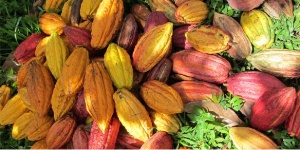- Home - News
- TWI News | TV
- Polls
- Year In Review
- News Archive
- Crime & Punishment
- Politics
- Regional
- Editorial
- Health
- Ghanaians Abroad
- Tabloid
- Africa
- Religion
- Election 2020
- Coronavirus
- News Videos | TV
- Photo Archives
- News Headlines
- Press Release
Business News of Saturday, 6 December 2014
Source: Reuters
Ghana, Ivory Coast may face slow cocoa season as trees tire
Several bumper cocoa crops have left trees in Ivory Coast and Ghana fatigued, farmers and exporters said on Friday, raising concern that the world's top two producers may struggle to rebound from a sluggish start to the season.
Leading cocoa grower Ivory Coast harvested a record crop of over 1.74 tonnes last season, topping a previous record set two years earlier. Ghana has roughly tripled its cocoa output over the past decade.
The Coffee and Cocoa Council (CCC), Ivory Coast's marketing board, has already lowered its production target to around 1.6 million tonnes.
"It's like with a man. You can work hard for a long period, but if you don't rest, you'll struggle to do half what you were able to do before," said Dominique Kouadio, explaining the drop in output from his plantation in Ivory Coast's Soubre region.
Cocoa arrivals at Ivorian ports in the first two months of the 2014/15 season were down around 10 percent from the previous season, according to exporters' estimates.
Ghana, meanwhile, saw a drop in cocoa purchases of nearly 62 percent through the first three weeks of the season.
Ghana's slow start may be related in part to delays in financing certified buyers but farmers blamed outbreaks of fungal black pod disease and a high mortality rate for flowers.
While the lower arrivals and purchases figures were largely anticipated by most traders, there remains disagreement over what will happen next.
Optimists predict that arrivals between January and March, which saw an uncharacteristically deep dip last season, will largely offset the early slump.
"The harvest this year is delayed. We'll have bigger volumes from January to March than in other years," one fund manager told Reuters.
Jonathan Parkman, joint head of agriculture at commodities brokers Marex Spectron, took a more conservative view.
"There are those saying arrivals are going to massively exceed last year and even exceed 2012/13," he said. "The argument against that is we don't think the survival will be good enough for that, given normal weather."
The first three months of the year coincide with the height of the dry season and the arrival of the dusty, desert Harmattan winds.
This season's fatigued trees will struggle to resist harsh conditions particularly if they are amplified by El Nino weather patterns, said Edward George, Head of Group Research at Ecobank.
"I think, if anything, that's where there's the risk that that weakness will persist," he said. "Inevitably it's going to be a smaller crop this year."
Entertainment










